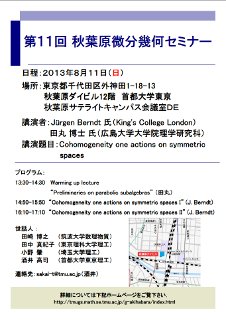
Last update : July 3, 2013
| 日程 | : | 2013年8月11日(日) |
| 場所 | : | 東京都千代田区外神田1-18-13 |
| 秋葉原ダイビル12階 首都大学東京 | ||
| 秋葉原サテライトキャンパス会議室DE | ||
| 講演者 | : | Jürgen Berndt 氏(King's College London) |
| 田丸 博士 氏(広島大学大学院理学研究科) | ||
| 講演題目 | : | Cohomogeneity one actions on symmetric spaces |
| 13:30-14:30 | Warming up lecture "Preliminaries on parabolic subalgebras" (田丸) | |
| 14:50-15:50 | Cohomogeneity one actions on symmetric spaces I (Berndt) | |
| 16:10-17:10 | Cohomogeneity one actions on symmetric spaces II (Berndt) |
Warming up lecture "Preliminaries on parabolic subalgebras"(田丸)
Theories of semisimple Lie algebras, such as Iwasawa decompositions and parabolic subalgebras, have been playing key roles for studying cohomogeneity one actions on symmetric spaces of noncompact type. In this talk, we give an introduction to these theories, and describe some explicit examples.Cohomogeneity one actions on symmetric spaces (Berndt)
This is joint work with Hiroshi Tamaru (Hiroshima University). An isometric action of a Lie group on a Riemannian manifold is of cohomogeneity one if the principal orbits have codimension one. If the Riemannian manifold is a symmetric space of noncompact type, then either the orbits form a Riemannian foliation, or there exists exactly one singular orbit. In [1] we classified the cohomogeneity one actions whose orbits form a foliation, and in [2] we classified those with a totally geodesic singular orbit. However, there are many cohomogeneity one actions with a non-totally geodesic singular orbit, as we have shown in [3] for the rank one case. In the recent work [4] we developed a conceptual approach for classifying the actions with a non-totally geodesic singular orbit. Geometrically this approach is based on the horospherical decomposition of the symmetric space, algebraically it is based on the Langlands decomposition of a real semisimple Lie algebra. The main result in [4] states that there are two construction methods for such cohomogeneity one actions. Roughly speaking, the first method is a canonical extension process using cohomogeneity one actions on certain totally geodesic submanifolds of the symmetric space, and therefore leads to a rank reduction procedure for the classification. The second type is more involved and not yet fully understood. In the talks we will discuss some of these results and some remaining open problems.
| JR 山手線・京浜東北線・総武中央線 | 「秋葉原駅」 | 徒歩約1分 |
| つくばエクスプレス | 「秋葉原駅」 | 徒歩約2分 |
| 東京メトロ日比谷線 | 「秋葉原駅」 | 徒歩約5分 |
| 東京メトロ日銀座線 | 「末広町駅」 | 徒歩約5分 |

問合せ先: 酒井 高司 sakai-t (at) tmu.ac.jp